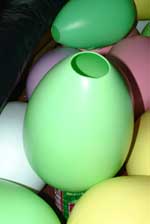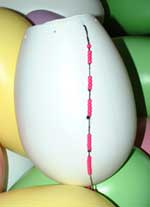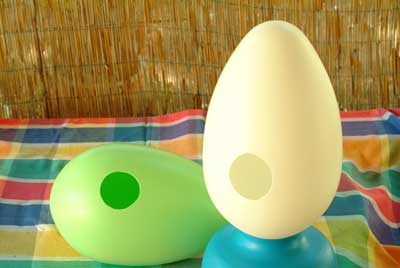
back to Rhythmweb.com/HOMEMADE/
Working with plastic egg shapes
(listen to the tones in the Egg
Ipu)
This particular batch of giant Easter eggs we came across was just dynamite. We bought out one Hobby Lobby, then another, until we had drained all the Hobby Lobbies in the metroplex of all their big Easter eggs.. The neighbors, bless 'em, began to smirk and glare a week or two after Easter, when the eggs didn't all go back in the attic. Thank God I have very understanding neighbors (They know I'm harmless.) As of late July, the experimentation continues...
The first giant plastic eggs we obtained in 2002 were
too soft, and did not make good instruments. [The more rigid the plastic,
generally, the better for instrumental use. The exception to this is for
bass instruments, like laundry tubs.]
The placement and size of the hole are crucial in determining how your egg ipu will sound. Three diverse approaches bear diifferent types of fruit.
 The
Traditional Cut - This was the first
cut we worked with, and there are some nice dynamics to be had from
this cut, although the results were not quite as we'd planned. The
primary reason for this is the plastic. Rigidity is the hallmark
of the gourd, from the bottom all the way to the spout. This gives
the bass a nice resonance when one plays it with the heel of one's
hand..the slap, likewise, is easy when played where the gourd had
touched the ground, on the very bottom, perhaps because it's a
little thinner there. Incidentally, we have since obtained
a magnificent gourd Ipu from the
Gourd Connection.
Highly recommended.
The
Traditional Cut - This was the first
cut we worked with, and there are some nice dynamics to be had from
this cut, although the results were not quite as we'd planned. The
primary reason for this is the plastic. Rigidity is the hallmark
of the gourd, from the bottom all the way to the spout. This gives
the bass a nice resonance when one plays it with the heel of one's
hand..the slap, likewise, is easy when played where the gourd had
touched the ground, on the very bottom, perhaps because it's a
little thinner there. Incidentally, we have since obtained
a magnificent gourd Ipu from the
Gourd Connection.
Highly recommended.
These new eggs are different. The thickness and
rigidity vary from egg to egg, and only some of them are usable, but the
good ones are quite workable. They initially seemed quite rigid, so the
first thing we did was cut the top off the small end, as if it were a
regular gourd. What we didn't realize was that much of the rigidity came
from the small curve of the egg shape itself, and once we cut that off,
the part near where we cut became relatively loose, and vibrated at a
different pitch than the base of the egg. The bigger the hole, the lower
the note (of the vibrating plastic) near the mouth, yet a HIGHER (Hemholtz
resonance) pitch from the base.. We could still get a bass note from the
bottom, but with less sustain.
There are two factors operating here: the diameter of the
vibrating ring (at the mouth) and the overall mass and shape of the larger
instrument. The lack of rigidity gives it these two voices.
 In
general, using a traditional cut works this way: the bigger the hole,
the LOWER the note produced by the vibrating ring at the mouth, but the
higher the (aerophonic)note produced from a palm on the bottom
In
general, using a traditional cut works this way: the bigger the hole,
the LOWER the note produced by the vibrating ring at the mouth, but the
higher the (aerophonic)note produced from a palm on the bottom
The note at the mouth is way down below the note on the bottom or udu stroke on the sound hole. With our first experiment, the lowest pitch was almost inaudible because of it's depth, and so we put a hole near the mouth, and strung a single snare of beads, knotting it from inside at either end. This instrument is not very loud, but when miked or playing in a quiet and peaceful setting, it is very useful. The buzzing of the snare makes the lowest pitch more audible. We have planned to use up to 8 strands of beads, but have not done this yet. Stay tuned :-
It is also useful to partially fil the top cut egg with various things, ranging from water to bells of various shapes and sizes, or even bb's or lead shot (always use COPPER JACKETED shot, available at a good gun shop, to keep from getting lead poisoning through your pores.). There is a small hole in the fat end of the eggs, which can be used for a strap or for stringing bells and beads onto the egg.
 The
Bottom Cut - This gives the longest aerophonic
wavelength, hence the deepest note from the aperture. The strength of
the larger curve is not compromised as much by the hole, and there is
more of a playing surface around it, so it works better as an aerophone..A
very useful cut. We plan to post more on this, but our sound card is down,
and we need to make some more recordings of the bottom cut juevones before
proceeding here..(at right" 3 bottom cut ipu ready for the apertures
to be sanded..Giant eggs cannot be clamped and are hard to hold still,
so they are tough to work on)
The
Bottom Cut - This gives the longest aerophonic
wavelength, hence the deepest note from the aperture. The strength of
the larger curve is not compromised as much by the hole, and there is
more of a playing surface around it, so it works better as an aerophone..A
very useful cut. We plan to post more on this, but our sound card is down,
and we need to make some more recordings of the bottom cut juevones before
proceeding here..(at right" 3 bottom cut ipu ready for the apertures
to be sanded..Giant eggs cannot be clamped and are hard to hold still,
so they are tough to work on)
The Log Drum approach - This involves putting non-circular slits and holes in various places to create different pitches. Some of these came out incredibly well. We have put in a lot of work on this, and will post more of our results when we have time..
 The
Egg ipu or Juevon - Stu's favorite cut.
This is the cut which makes the sound hole most accessible to the player
for manipulation of the pitch. it leaves both ends of the egg intact,
which favorably affects the rigidity. The sound hole must be the right
size and in exactly the right spot to put the air column in tune with
the overall highest pitch of the egg (The sound obtained by holding tightly
and playing the smallest end, right on the tip), but even an unmatched
sound hole can yield interesting and useful results. Truly the Juevon
or Egg Ipu is a classic instrument. the best ideas are the simple ones.
Research is ongoing, and we are currently preparing to apply for a patent
on certain versions that work best for us..remember,
you saw it HERE first, at RHYTHMWEB :-)
The
Egg ipu or Juevon - Stu's favorite cut.
This is the cut which makes the sound hole most accessible to the player
for manipulation of the pitch. it leaves both ends of the egg intact,
which favorably affects the rigidity. The sound hole must be the right
size and in exactly the right spot to put the air column in tune with
the overall highest pitch of the egg (The sound obtained by holding tightly
and playing the smallest end, right on the tip), but even an unmatched
sound hole can yield interesting and useful results. Truly the Juevon
or Egg Ipu is a classic instrument. the best ideas are the simple ones.
Research is ongoing, and we are currently preparing to apply for a patent
on certain versions that work best for us..remember,
you saw it HERE first, at RHYTHMWEB :-)
Please - it's egg Ipu, not eggy poo :-)
Here's a page devoted to the Egg Ipu, also known as the Juevon
© 2004 Eric Stuer All rights reserved
RHYTHM WEB™; and RHYTHMWEB™;
are trademarks, and any unauthorized use of the names is a violation
of applicable law.